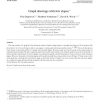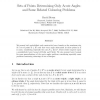130
Voted
COMGEO
2007
ACM
15 years 25 days ago
2007
ACM
The slope-number of a graph G is the minimum number of distinct edge slopes in a straight-line drawing of G in the plane. We prove that for Δ 5 and all large n, there is a Δ-reg...
104
Voted
IJCGA
2006
15 years 25 days ago
2006
We obtain lower bounds in the algebraic computation tree model for deciding the separability of two disjoint point sets. In particular, we show (n log n) time lower bounds for sep...
79
Voted
IPL
2008
15 years 25 days ago
2008
In this paper, we show how we can derive lower bounds and also compute the exact distortion for the line embeddings of some special metrics, especially trees and graphs with certai...
125
Voted
BMCBI
2007
15 years 25 days ago
2007
Background: Multiple sequence alignment is fundamental. Exponential growth in computation time appears to be inevitable when an optimal alignment is required for many sequences. E...
102
Voted
DC
2006
15 years 26 days ago
2006
Some well-known primitive operations, such as compare-and-swap, can be used, together with read and write, to implement any object in a wait-free manner. However, this paper shows ...
102
Voted
CORR
2006
Springer
15 years 26 days ago
2006
Springer
We derive new upper and lower bounds on the fading number of multiple-input single-output (MISO) fading channels of general (not necessarily Gaussian) regular law with spatial and ...
COMBINATORICS
2006
15 years 26 days ago
2006
We present both probabilistic and constructive lower bounds on the maximum size of a set of points S Rd such that every angle determined by three points in S is acute, considerin...
117
Voted
CC
2006
Springer
15 years 26 days ago
2006
Springer
We improve upon indirect diagonalization arguments for lower bounds on explicit problems within the polynomial hierarchy. Our contributions are summarized as follows.
114
click to vote
CC
2006
Springer
15 years 26 days ago
2006
Springer
We show that any 1-round 2-server Private Information Retrieval Protocol where the answers are 1-bit long must ask questions that are at least n - 2 bits long, which is nearly equa...
117
Voted
EOR
2008
15 years 27 days ago
2008
This paper is a study of the car sequencing problem, when feature spacing constraints are soft and colors of vehicles are taken into account. Both pseudo-polynomial algorithms and ...







